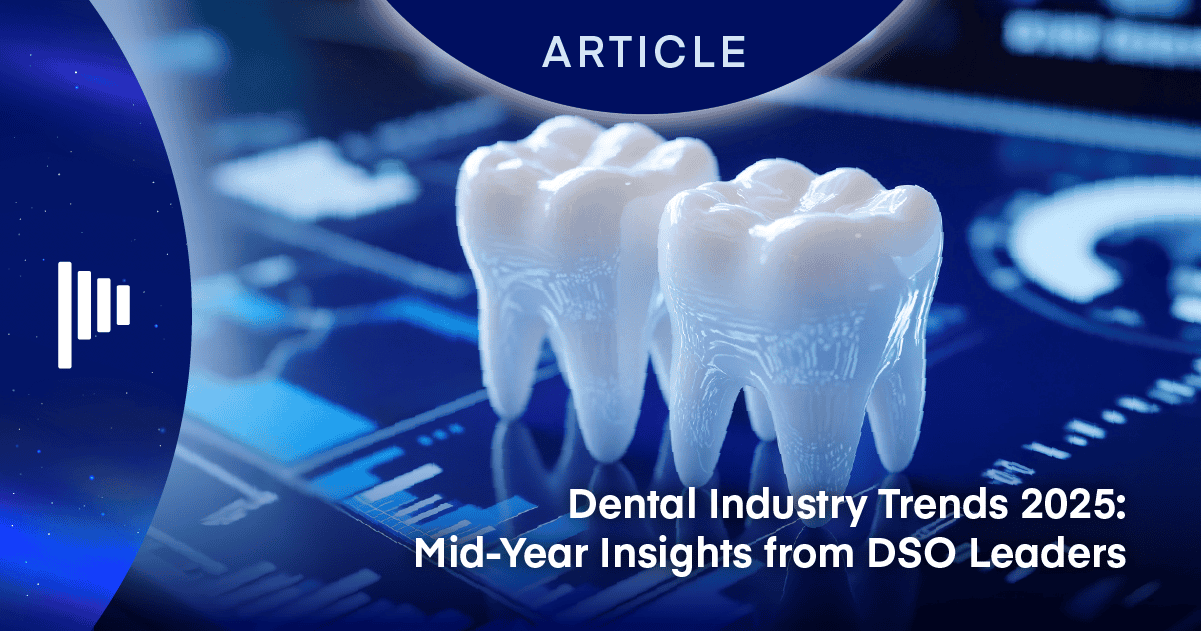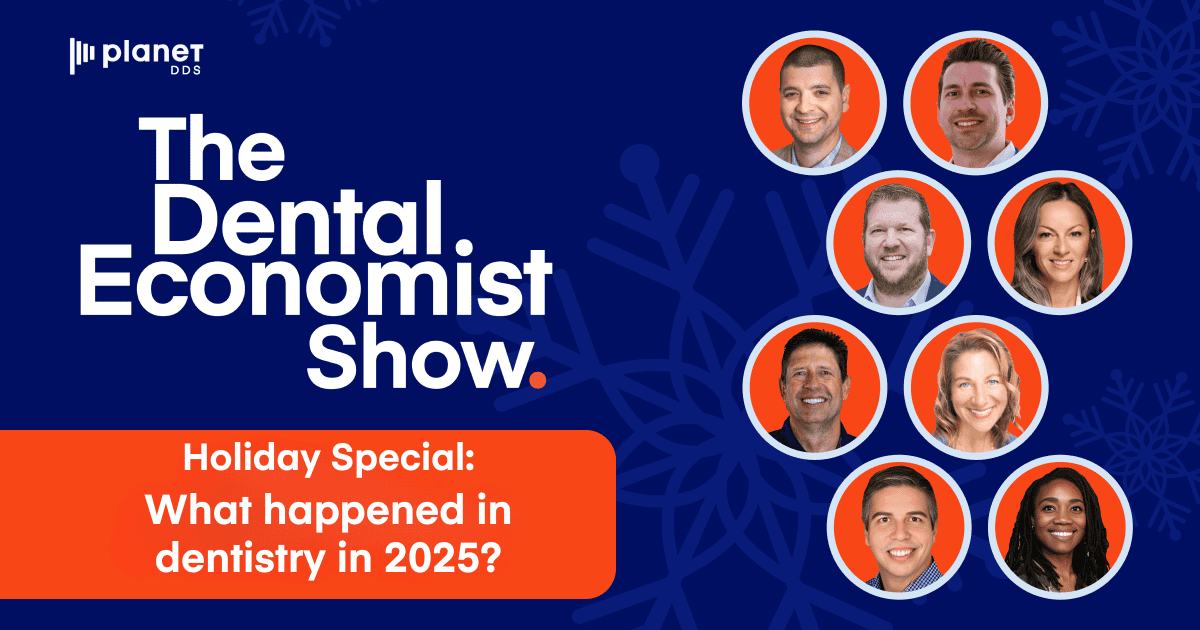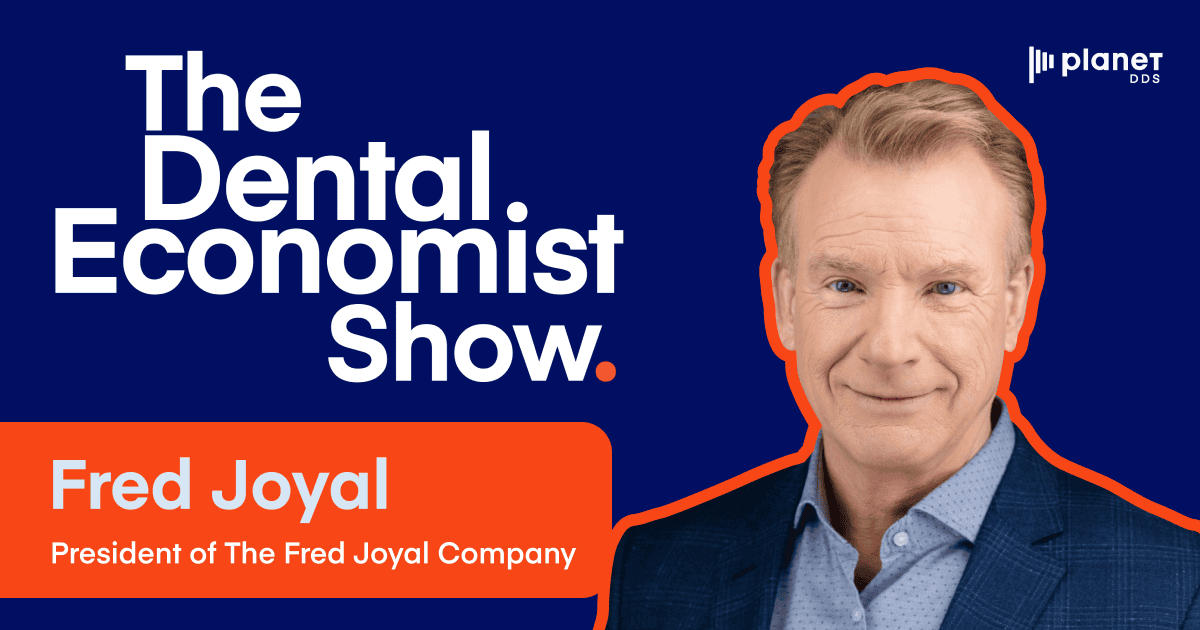Dental Industry Trends 2025: Mid-Year Insights from DSO Leaders

The article was written by Planet DDS and originally published as a two-part series in DrBicuspid.com.
Rising costs, staffing shortages, shifting patient expectations, and cautious consumer behavior have shaped the first half of 2025 for dental support organizations (DSOs). But while the pressure hasn’t let up, many industry leaders are adapting quickly and finding new ways to build resilience.
From accelerated AI adoption to improved patient communication strategies, DSO executives are offering a real-time look at what’s working and what’s weighing on performance.
Adopting AI and Technology
Technology continues to dominate strategic planning, but integrating new systems without disrupting operations remains a balancing act.
Steve Bilt, CEO of Smile Brands (600 locations in 29 states), framed the challenge this way: “The technology boom in the sector has continued. Dental historically has been a second mover on the adoption curve and it feels like there is a decade of tech opportunities presenting all at once. As I’m fond of saying, ‘it could be good and could be bad.’ The operator’s dilemma is how much can our organization uptake without creating confusion that takes away from day-to-day execution versus enhancing it?”
Yahya Mansour, DDS, co-founder and chief dental officer at Rodeo Dental & Orthodontics (50 locations in Arizona), shared how his team is leveraging technology despite the challenges: “Strategic investments in AI diagnostics and workflow optimization helped offset inefficiencies and protected margins. Overall, performance remained resilient, but agility was key.”
“We also saw a rapid adoption of digital technologies including AI, intraoral scanning, and 3D printing, which has improved diagnostics and operational efficiency across the network,” shared Arwinder Judge, DDS, chief clinical officer at Aspen Dental (1,100+ locations across the U.S.).
Dale Hockel, CEO of Great Expressions Dental Centers (GEDC, 250 locations in 9 states), noted, “Patient demand remained resilient and digital engagement continued to rise, reinforcing the importance of convenience and access. GEDC leaned into opportunities by accelerating investments in AI-powered diagnostics, workflow automation, and infrastructure enhancements to support scalable growth.”
Shifts in Consumer Behavior
Economic uncertainty continues to affect consumer behavior, especially when it comes to larger or elective treatment plans.
“The first half of 2025 showed some long-awaited normalization in the labor markets,” said Bilt of Smile Brands. “There appears to be a tenuous equilibrium slowly returning amid unprecedented levels of policy and global volatility. The consumer has shown a similar pattern of concern, although has generally been accepting of the need to continue with dental treatment rather than risk deferring essential services.”
William Harvey III, DDS, founder of Sound Dental Partners (10 locations in North Carolina), explained how his team are adjusting to this shift: “We’ve noticed the economic uncertainty since the start of the year has led many patients to focus more on dental services covered by their PPOs and dental benefit plans, and less on fee-for-service treatment. We renegotiated our insurance plan rates, focusing on our relationships with preferred benefit providers and reducing the number of contracted plans with lower fees.”
“In addition, economic uncertainty was, and to a degree still is, another significant trend affecting consumer spending,” noted Samson Liu, DDS, CEO of SOHDental (45 locations in 10 states). “During the first half of 2025, the ongoing inconsistency in political messaging affected consumer confidence, contributed to decreased patient spending and lowered case acceptance in discretionary dental services and larger treatment plans, such as cosmetic services, implants and full mouth cases.”
“The first half of 2025 has been defined by resilience and adaptation,” shared Mick Janness, CEO of Oakpoint (42 locations in North and South Carolina). “On the positive side, we’ve seen solid same-store growth across our network, with many practices reporting consistent patient volume despite broader economic uncertainty. We continue to focus on facility and systems optimization with our company-wide rollout to Square, which has improved our performance metrics.”
Staff Shortages and Rising Costs
While some labor markets are showing signs of stability, staffing shortages and wages continue to drive up overhead and impact operations. “Labor market pressures have persisted, placing additional strain on margins,” noted Hockel of GEDC.
“Staffing shortages and rising overhead costs remain our biggest hurdles, as do those of many of our DSO counterparts,” said Janness of Oakpoint. “It requires us to be creative with retention strategies and practice management support. We’ve responded by enhancing our shared services model, helping practices achieve better economies of scale while maintaining their clinical autonomy.”
Clinician development also remains a top priority for Aspen Dental. “Workforce dynamics remain a challenge across the dental industry as a whole,” explained Judge. “Recruiting and retaining dental professionals requires ongoing investment in development and support. Which is why we’ve doubled down on our commitment to support clinician development through TAG University, maintain and grow relationships with the best industry partners and provide the tools and technologies that clinicians need so they can focus on what they do best: providing care.”
Strengthening Patient Engagement
Some organizations are seeing positive results by focusing on patient care and engagement. “In the first half of 2025, we saw strong momentum in patient volume and demand for comprehensive care, especially in pediatric and specialty service, a positive sign of growing community and patient trust,” said Mansour of Rodeo Dental.
Judge also reported encouraging signs at Aspen Dental: “We saw continued growth in patient demand for comprehensive care—from preventive to cosmetic services—which speaks to how much oral health is being prioritized. Patients are more informed, and they are looking for long-term solutions, which aligns well with Aspen Dental’s mission to deliver personalized, high-quality care.”
Dmitry Burshteyn, CEO of Progressive Dental Management (15 locations in New England), highlighted several initiatives that improved both morale and case acceptance: “In the first half of 2025, we saw encouraging gains in case acceptance driven by bold, experimental shifts in culture and communication. We introduced daily micro-huddles, simplified case presentation scripts, and focused on training that aligned team members across all roles.
“We also empowered our doctors and managers with real-time feedback tools, which built trust and improved confidence during patient consultations. The result was a noticeable boost in team morale and patient treatment acceptance rates.
“On the other hand, rising operational costs have continued to pressure margins. The challenge has been maintaining growth while tightening systems, and we’ve responded by focusing intensely on efficiency without compromising the patient, partner, or employee experience,” said Burshteyn.
“Despite macroeconomic pressures, including inflation and ongoing reimbursement compression, GEDC delivered strong performance in same-store production, reflecting our steadfast focus on patient-centered care,” noted Hockel.
Building Long-Term Value
Looking ahead, DSO leaders are focused on staying flexible while building for growth. That means investing in clinician support, operational systems, and scalable infrastructure even as conditions remain uncertain.
“Our commitment to improving both patient and provider experiences—through clinical quality initiatives and operational efficiency—has positioned us to navigate short-term pressures while building long-term value,” expressed Hockel. “Integration of new technologies at scale remains a challenge, but we are making steady progress in aligning innovation with the expectations of today’s dental consumer.”
Drive Strategic Growth in 2025
Midway through 2025, one thing is clear: DSOs aren’t standing still. Executives are focused on expanding access to care, enhancing patient care and engagement, and continuing to invest in their clinical team, technology, and leadership as they head into the second half of the year. The ultimate goal is to stay resilient and drive strong clinical and business performance moving forward.
Looking to strengthen your DSO or dental group growth strategies? Contact us today.



